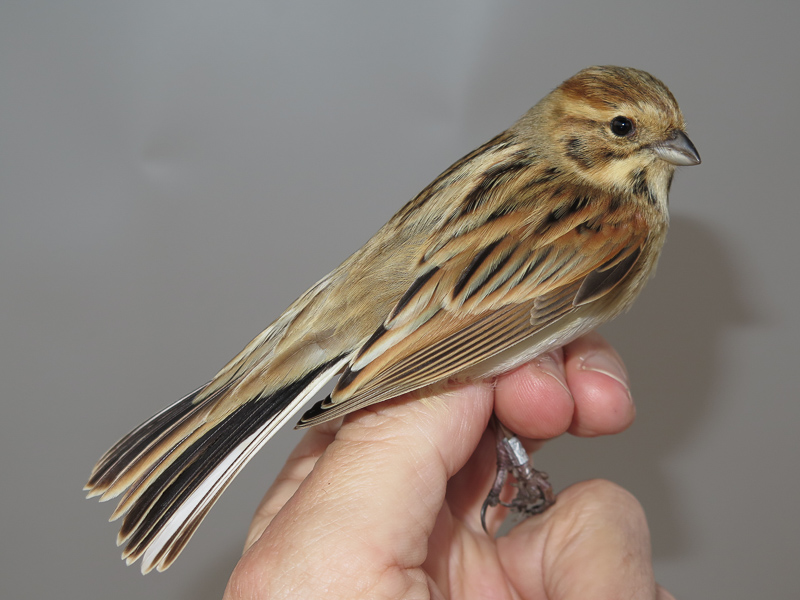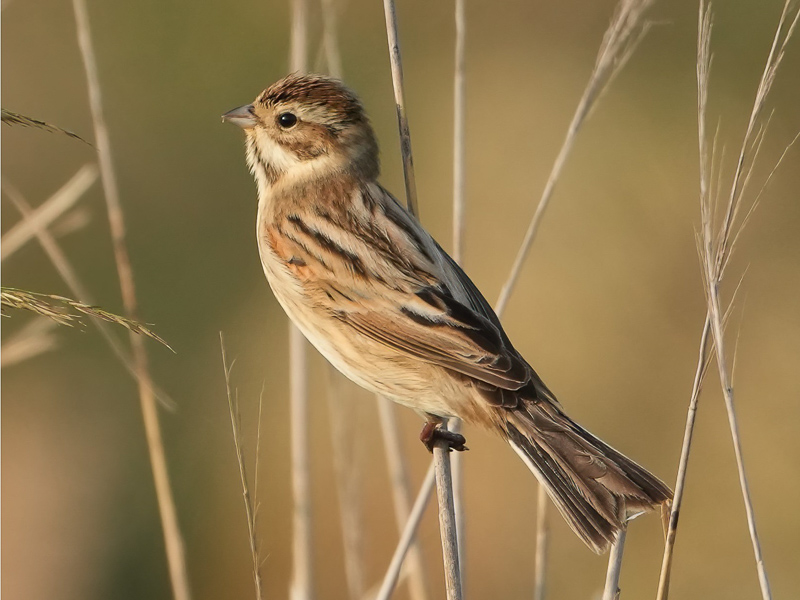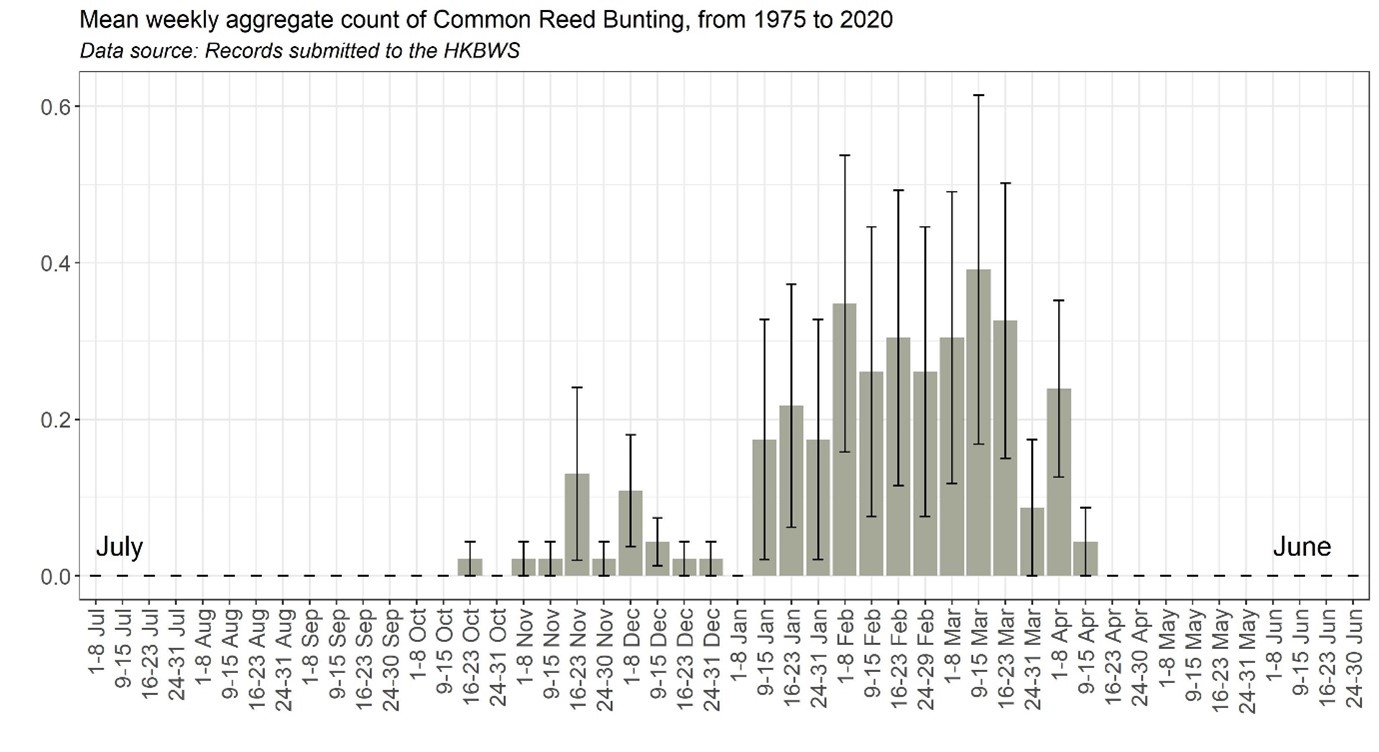Common Reed Bunting Emberiza schoeniclus 蘆鵐
Category I. Scarce winter visitor to reed marsh.
IDENTIFICATION

Nov. 2022, Paul Leader.
14-16.5 cm. Large, rather pale bunting in non-adult male plumages. In winter shows a pale sandy and largely plain rump. Has well-marked mantle ‘tramlines’, noticeably pale sandy central tail feathers and a variable amount of rufous in the wing, with at least the lesser and median coverts rich rufous. Bill is usually large and bulbous. The majority of records are considered attributable to E. s. pyrrhulina.

Apr. 2023, Paul Leader.
Males in breeding plumage (rare in HK) show more rufous in the wing and have a black head and throat separated by a broad white malar, a pale collar, mid-brown mantle streaked darker that has pale lines at the side and dull buff underparts with little streaking.

Nov. 2016, KWOK Tsz Ki.
There are several records of a duller, smaller and smaller-billed taxon which shows less rufous in the wing and a less contrast in the tail; these are thought to be either passerina or parvirostris. Most birds that occur are in non-adult male plumage. Female and immature birds have a poorly-marked head pattern distinguished mainly by a broad pale malar bordered either side by narrow darker borders and an indistinct supercilium.

Oct. 2022, Paul Leader.
Some pale birds may be very similar to Pallas’s Reed Bunting in having blackish, triangular malar stripes, a grey-brown, largely unstreaked and pale rump and sandy tones generally. Such birds are distinguished by a lack of rufous lesser coverts (Leader 1994). Usually, the large bill with strongly convex culmen would also indicate Common Reed Bunting, but this individual has a small bill with a straight culmen.
VOCALISATIONS
The usual call is a downslurred ‘tsyooo’.
Also gives a slurred ‘tsyoop’, a flatter ‘chzzt’ and a high-pitched, thin ‘tseee’. All can be heard in this recording.
DISTRIBUTION & HABITAT PREFERENCE
Apart from records at Shuen Wan, Long Valley and Sha Lo Tung, all have occurred in the Deep Bay area. The favoured habitat is reed marsh or areas of tall rank grass.
OCCURRENCE
Rare winter visitor with extreme dates of 22 October 2004 and 15 April 1989. Rare before the turn of the year, it is most often seen from the second week of January to the first week of April, mainly in February and the first three weeks of March.
Although most records concern single birds, some are of small parties, and several groups have remained for several weeks. The highest reported number is seven (a male and six females) trapped at Mai Po from 10 January to 21 March 1993, up to five from 7 February to 14 March 1982 and five on 20 November 2014.
BEHAVIOUR, FORAGING & DIET
Common Reed Buntings in HK are often very elusive and appear to spend much of their time foraging inside reed beds. For example, during the period from 10 January to 21 March 1993, when six birds were trapped in the same reed bed at Mai Po, there was only a single sight record of one bird on 6 February. This same group provided evidence that observations did, indeed, relate to the same birds (rather than birds passing through) in that one trapped on 30 January was retrapped on 6 March, and a bird first trapped on 6 March was trapped again on 21 March.
Common Reed Buntings seen foraging have frequented medium or large stands of reed Phragmites spp. where they feed on the seeds.
RANGE & SYSTEMATICS
Approximately 20 subspecies are recognised across its range, which extends from western Europe across Siberia to Japan, though the range in Asia is not known well and currently it appears disjunct. In China breeds in scattered areas of Xinjiang and the northeast, and winters in north Xinjiang, Nei Monggol and the east down through southeastern coastal provinces (Liu and Chen 2021).
The regular taxon in HK is E. s. pyrrhulina, which breeds from south central Siberia and northeast Mongolia to the Kamchatka Peninsula, Kuril Islands and Japan. E. s. passerina breeds in northwest Siberia, while E.s. parvirostris breeds in central Siberia (Copete and Christie 2021).
CONSERVATION STATUS
IUCN: Least Concern. Population trend decreasing.
Figure 1.

Byers, C., U. Olsson and J. Curson (1995). Buntings and Sparrows. A Guide to the Buntings and North American Sparrows. Pica Press, UK.
Copete, J. L. and D. A. Christie (2021). Reed Bunting (Emberiza schoeniclus), version 1.1. In Birds of the World (J. del Hoyo, A. Elliott, J. Sargatal, D. A. Christie, and E. de Juana, Editors). Cornell Lab of Ornithology, Ithaca, NY, USA. https://doi.org/10.2173/bow.reebun.01.1
La Touche, J. D. D. (1931-34). Handbook of the birds of Eastern China Vol. 2. Taylor and Francis, London.
Leader, P. J. (1994) Eurasian Reed Bunting – a brief review of its identification. Hong Kong Bird Report 1993: 193-194.
Liu, Y. and S. H. Chen (eds) (2021). The CNG Field Guide to the Birds of China (in Chinese). Hunan Science and Technology Publication House, Changsha.

